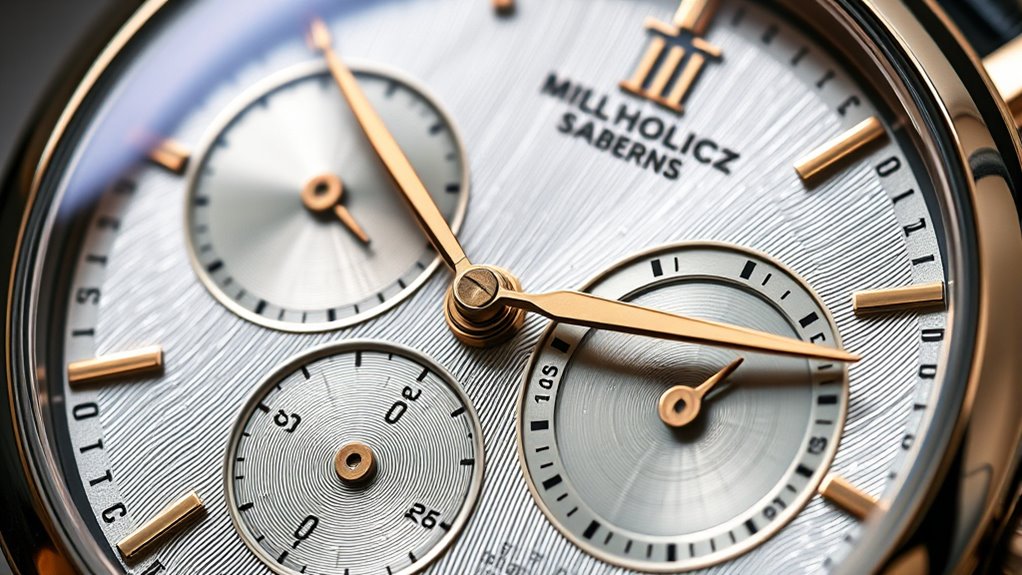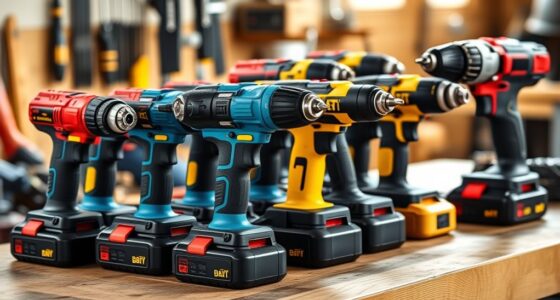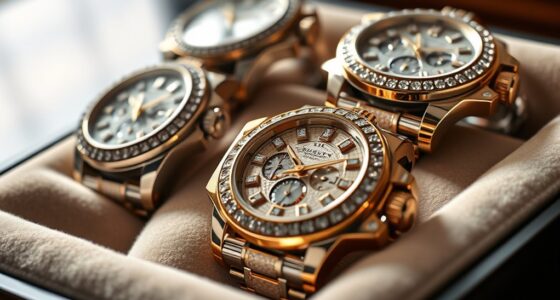Watch complications like chronographs and calendars transform your timepieces from simple tools into sophisticated marvels. Chronographs let you measure elapsed time, perfect for sports or aviation, while calendars keep you organized with day, date, or month displays. Other features, such as moon phases or dual time zones, add artistry and practicality. These complications showcase expert craftsmanship and advanced engineering, making watches more than just accessories. Keep exploring to discover how these intricate features elevate your watch experience.
Key Takeaways
- Chronographs are stopwatch functions allowing precise timing of events, often featuring additional subdials for seconds, minutes, and hours.
- Calendar complications display date, day, month, or year, often integrated with moon phase or leap year indicators.
- Watch complications like dual time and world time help track multiple time zones simultaneously.
- Moon phase complications depict lunar cycles and are valued for their aesthetic and mechanical complexity.
- Complications enhance both functionality and artistry, transforming watches into intricate horological masterpieces.

Watch complications are additional features or functions added to a timepiece beyond basic timekeeping, showcasing a watchmaker’s craftsmanship and technical skill. These intricate details elevate a watch from a simple accessory to a marvel of engineering, offering more than just the hour, minute, and second. Two popular complications you might encounter are dual time and moon phase indicators. Both serve practical purposes while adding aesthetic appeal, reflecting the artistry and precision behind watchmaking.
When you see a dual time complication on a watch, it allows you to track two different time zones simultaneously. This feature is especially useful if you travel frequently or communicate across time zones. Imagine setting the primary time to your local zone and the secondary to a loved one’s city or your business partner’s location. Dual time watches often display a separate hour hand or a dedicated subdial, making it easy to read at a glance. The craftsmanship involves complex mechanics to ensure the second time zone remains accurate without disrupting the primary timekeeping functions. These watches often appeal to professionals and globetrotters, showcasing the watchmaker’s skill in seamlessly integrating additional movements without sacrificing reliability or style.
The moon phase complication, on the other hand, offers a glimpse into the lunar cycle. It displays the current phase of the moon, whether it’s new, waxing, full, or waning. You might think it’s purely decorative, but it actually requires precise calibration and a complex gear train to track the lunar cycle accurately over 29.5 days. This complication appeals to those who appreciate astronomy, tradition, or simply enjoy the poetic connection to nature. Moon phase watches are often designed with artistic dials, featuring detailed moon images and starry backgrounds, turning the dial into a miniature celestial scene. The craftsmanship involved in creating a smooth, accurate moon phase indicator demonstrates a high level of skill, as watchmakers must ensure the complication remains precise for decades with minimal adjustments. Additionally, understanding the mechanics of watch complications can deepen appreciation for their engineering marvels.
Both dual time and moon phase complications exemplify how watchmakers combine functionality with artistry. They transform a basic timepiece into a personal tool that respects tradition while embracing innovation. Whether you’re a traveler who needs to keep track of multiple zones or an admirer of celestial movements, these complications add depth and character to your watch. They are not just about telling time—they are about experiencing a piece of horological mastery that connects you to the intricate mechanics and timeless beauty of watchmaking.
Frequently Asked Questions
How Do I Set a Chronograph Accurately?
To set your chronograph accurately, start by understanding its stopwatch functions and how they work. Press the start button to begin timing, then stop it at a known interval, like 60 seconds. Use the chronograph calibration feature if available to fine-tune the timing. Adjust the hands or digital display as needed, ensuring your chronograph is synchronized with a reliable time source for precise measurements.
What Is the Most Complex Watch Complication?
The most complex watch complication is the minute repeater, a true feat of horological innovation. It chimes the time on demand, blending intricate watch movement with precise craftsmanship. While simple dials show hours and minutes, this complication transforms a watch into a symphony of sound. You can appreciate how this juxtaposition of sound and time showcases the extraordinary ability of watchmakers to push the boundaries of horological innovation.
Are Calendar Complications Prone to Damage?
Calendar complications can be prone to damage if they’re not properly maintained, especially since they often include delicate gears and mechanisms. Water resistance plays a big role here; if it’s compromised, moisture can damage the complication’s components. Regular maintenance is essential to guarantee proper water resistance and keep the calendar functioning accurately. Without proper care, these complications risk malfunctioning or requiring costly repairs over time.
How Long Do Watch Complications Typically Last?
Watch complications typically last many years, often decades, but their durability depends on quality and maintenance. You should expect watch durability to be high if you regularly service your watch and handle it carefully. Proper complication maintenance ensures your chronograph or calendar functions stay accurate and reliable over time. Neglecting maintenance can lead to wear and damage, reducing the lifespan of your watch’s complications and affecting overall performance.
Can Complications Be Added to Any Watch?
You can’t just sprinkle complications onto any watch like toppings on a pizza. Watch customization and complication integration depend on the watch’s design and movement. Some watches are built with space and mechanics for extra features, while others aren’t. To add complications, you need a skilled watchmaker who can craft and fit these intricate parts seamlessly into your timepiece’s story, turning it into a personalized masterpiece.
Conclusion
Remember, a watch is more than just a way to tell time — it’s a reflection of craftsmanship and innovation. With complications like chronographs and calendars, you can elevate your wristwear to new heights. As the saying goes, “The devil is in the details.” So, choose your complications wisely, and let your watch be a true expression of your style and precision. After all, it’s the little things that make all the difference.









